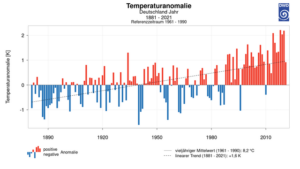Can climate change bring food crises? Consider the course of deviations in temperatures from annual averages in Germany between 1881-2021. This helps to understand the importance and seriousness of the work to be done.
Originally posted on the site of Nazimi Acikgöz.

All the world organizations have already grasped the importance of this climate change, and they have rolled up their sleeves to take urgent measures regarding the adverse effects of the event on food and agriculture. FAO, the European Commission (EC), the International Fund for Agricultural Development (IFAD), and the World Food Program (WFP) have recently signed a framework cooperation agreement to meet the food requirement. The aim is to develop effective, coordinated, and sustainable new strategies for food safety and security.
Climate change and food crises
There are many other compelling reasons. First of all, the expectation is that the population will reach 9.5 billion in 2050. Cultivation area data show a production area of 4.3 hectares per capita in 1960, but this figure dropped to 3 in 1980 and to 1.8 hectares in 2020. Let’s try to estimate the number of people fed by one hectare of agricultural land: In 1960, one hectare fed 0.7 people, in 1980 1.5 people, in 2000 2.7 people. In 2020, one hectare should feed 4.2 people. From this point of view, the inevitability of buying more products per unit area emerges in the coming years.

Another factor that comes with climate change and will negatively affect agriculture is that diseases and pests may shift to the north with increasing temperatures. One cannot even imagine its possible effects. In the face of the increasingly negative effects of these changes, the following question comes to mind: does climate change create food crises?
Agriculture and sustainability
At this stage, let’s first try to answer the question of whether we can make agricultural production sustainable.
– Some countries are changing their production models. Could it be an example that Saudi Arabia ended wheat farming in 2016 for water-saving purposes?
– Is it possible to create new areas for some productions, such as French vineyard growers shifting their vineyard facilities to the UK?
– How effective can production increases be through new practices such as stubble planting, second crop (even four crops per year in paddy can be obtained in China), soilless farming, vertical farming, and permaculture?
– Plant and animal breeding are reliable resources to ensure tomorrow’s foodstuffs in the face of climate change. The fact that drought-resistant corn varieties have already been registered and delivered to the producer, mainly by genetic engineering and biotechnology, is proof of this. So, can these and similar applications be enough?
– The hybrid technique, which provides an increase in yield in foreign pollinated products, was applied to a self-pollinated rice paddy in China and this country got rid of being a rice importer by planting hybrid paddy in 56% of the paddy cultivation areas. So, is there a chance to increase wheat production by developing hybrid wheat varieties?
– In methods such as CRISPR-Cas9, new genotypes are created by silencing the targeted gene with the help of temporary DNA-cutting enzymes, increasing or decreasing its effect, and subjecting it to micro-mutation, without any external gene transfer, like in GMOs. With these new breeding techniques, plants and animals have been developed in many countries. Can’t such biotechnological innovations be brought into the bioeconomy of other countries, including the EU and Turkey?
– We can achieve a major change in agricultural production by reducing society’s meat consumption. In this regard, developments in plant-based artificial meat and fish technologies are promising. Plant-based meat, milk, cheese, etc., saving the use of land and water, and frequently put forward in abating climate change, will relieve livestock and fisheries. Cannot the promotion of production and consumption be generalized?
– By halving crop losses, agricultural production will be able to increase by 20% in the 2050s.
Even if we answer all these questions positively, it is a fact that the climate crisis, whose degree cannot be fixed, will be the biggest threat to food security.
Interesting? Then also read:
Biostimulants as a sustainable farming solution in modern agriculture
The treeline, witness to climate change
Why didn’t decades of climate concern influence global emissions growth?
